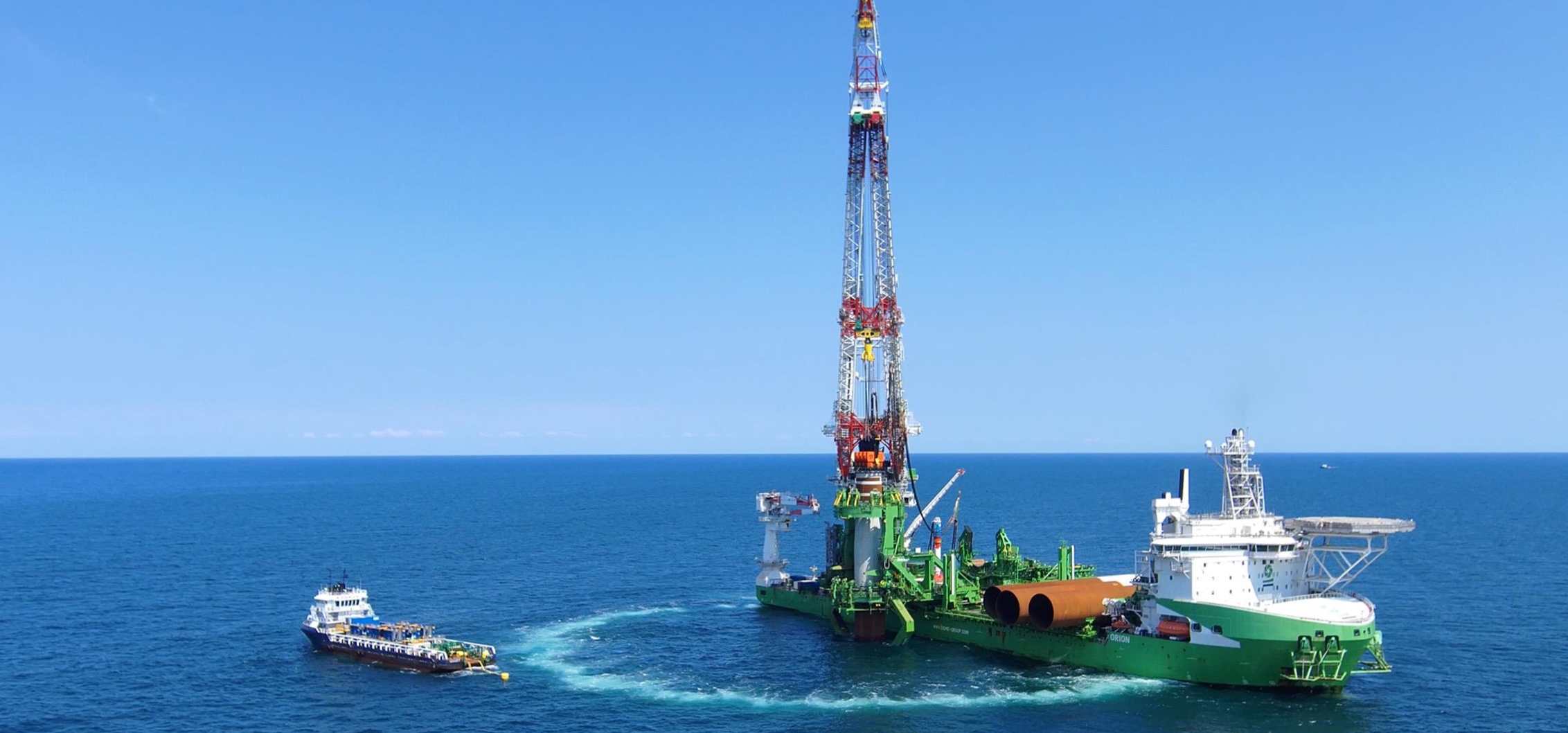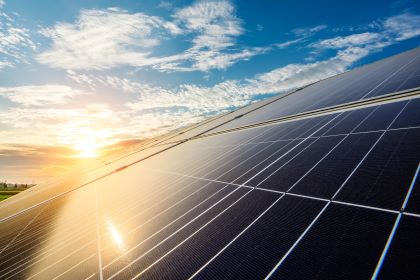Dominion Energy says the Coastal Virginia Offshore Wind (CVOW) project is more than one-third complete, with about $4.5 billion invested so far on the 2.6-gigawatt (GW) wind farm.
Charybdis, the first Jones Act-compliant offshore wind turbine installation vessel, is under construction in Texas for the project. The vessel is nearly 90% complete, the company said. With the main crane structures installed and main engine load testing underway among other work, vessel construction is expected to be finished in late 2024 or early 2025.
Development of the massive wind project progresses as the U.S. aims to increase its offshore wind capacity and lower greenhouse gas emissions. CVOW, which will consist of 176 turbines and three offshore substations, is the largest offshore wind project being developed in the U.S. Located on a nearly 113,000-acre lease area off Virginia Beach, CVOW is expected to provide enough power for about 660,000 homes when complete by the end of 2026.
“We’re confidently on our way to achieving our goal of 70 [monopoles] to 100 monopoles installed during the first of two planned installation seasons, and another important milestone installation of scour protection for the monopoles began in June,” Dominion Energy CEO Bob Blue said Aug. 1 on the company’s second-quarter 2024 earnings call. “We started work on 23 monopoles to date, which is consistent with the final project schedule.”

With all required federal permits in hand, progress is also being made in other areas: two of three offshore substation topside structures are complete, 161 miles of onshore underground cable has been manufactured and about half of the 600 miles of offshore cable for the wind project has been produced, he said.
“In fact, we expect to begin installing the export cable later this quarter,” Blue added. “Schedule for the manufacturing of our turbines remains on track. Fabrication of the towers for our turbines began in June.”
Turbine installation is scheduled to start in 2025.
By the end of the year, Dominion Energy said it expects to have spent about $6 billion on the project. The project’s expected levelized cost of energy remained unchanged at $73 per megawatt-hour (MWh). CVOW’s overall capital budget held steady at $9.8 billion including contingency. Unused contingency was $143 million.
“The current contingency level continues to benchmark competitively as a percentage of total budgeted cost when compared to other large infrastructure projects we’ve studied and ones that we've completed in the past,” Blue said. “We’ve been very clear with our team and with our suppliers and partners that delivery of an on-budget project is the expectation.”
Here’s a look at other renewable energy news this week.
Biofuels
Neste, United Airlines Ink SAF Deal

Renewable fuels company Neste on July 31 said it will provide up to 1 million gallons of sustainable aviation fuel (SAF) to United Airlines through the end of 2024, building on its existing SAF partnership.
Sourced from waste such as used cooking oil and animal fat waste, the SAF will be used at the Chicago O’Hare International Airport. The first supply of SAF, which will be blended with conventional jet fuel, is expected to arrive at the airport via pipeline in August. It will be transported from Neste’s SAF terminal capacity in Houston.
“It underlines our commitment to supporting the U.S. aviation industry in its efforts to decarbonize and shows the important role that policy supports like the federal SAF 40B credit and the Illinois’ SAF Purchase Credit play in accelerating SAF usage,” Alexander Kueper, Vice President, Renewable Aviation Business at Neste, said of the partnership. “We continue supporting United’s roadmap to achieve its emission goals and look forward to expanding our cooperation at other airports across the globe.”
Though United and others airlines have worked to increase SAF usage amid ambitions to lower emissions, SAF accounts for less than 0.1% of the total jet fuel used by major airlines. Costs, demand and limited supply are among the factors.
Neste said its Neste MY Sustainable Aviation Fuel reduces greenhouse gas emissions by up to 80% over the fuel’s life cycle, compared to using conventional jet fuel.
Energy storage
United Power, Ameresco Complete BESS Projects
Ameresco Inc. and Colorado-focused electric cooperative United Power have completed construction of several battery energy storage system (BESS) projects in the state, the companies said July 29.
The U.S. has seen a surge of battery energy storage system projects to help stabilize power grids as more intermittent renewable energy come online.
Designed to provide a combined 78.3 megawatts (MW) and 313.34 megawatt-hours of battery storage capacity, the systems are spread across multiple sites on United Power’s electric distribution system. Five of the sites have been placed in service, according to a news release, and three more sites are expected to enter service by the end of the summer.
“The use of batteries on our distribution network is essential to a resilient and responsive power grid, and we are excited to be moving ahead with one of the most aggressive plans for such systems,” said United Power CEO Mark A. Gabriel. “These battery energy storage systems will allow us to balance our power needs throughout the day and incorporate local renewables more efficiently.”
Hydrogen
TES, Palantir Form AI Partnership
Electric natural gas producer Tree Energy Solutions (TES) and Palantir Technologies have formed a partnership to leverage the tech company’s artificial intelligence software, according to a July 29 news release.
“Through this partnership, Palantir Foundry and Palantir Artificial Intelligence Platform (AIP) will support TES in supply chain management, simulation and scenario modeling for investment
optimization, site selection, asset management, carbon emissions tracking, and modeling the
energy transformation pipeline,” the release states.
TES makes electric natural gas (e-NG) derived from hydrogen. Chemically identical to natural gas, e-NG is made by combining green hydrogen with biogenic or recycled CO2.
Enagás Gets First Nod to Develop Spanish Section of H2MED Hydrogen Pipeline
The Spanish government gave a first go-ahead on July 30 to gas grid operator Enagás to start developing the Spanish section of a planned trans-European hydrogen pipeline and related hydrogen infrastructure projects.
Enagás, in which the Spanish state owns a 5% stake, is moving to transition from its traditional role as a natural gas grid operator to managing a network of hydrogen infrastructure, taking advantage of the Spanish government's plans to become a European hub for green hydrogen.
Key to the government’s and the company’s plans is the flagship H2MED hydrogen pipeline project, which would connect the Iberian Peninsula to France and on to Central Europe by 2030.
Enagás is teaming up with French, German and Portuguese peers to develop the project. It expects net investment of around 3.2 billion euros (US$3.5 billion) through 2030 to develop its hydrogen projects, including the H2MED corridor.
On July 30, the Spanish government said Enagás could move forward with hydrogen projects deemed of European interest and part of the H2MED corridor, including an interconnection with Portugal, an underwater pipeline between Spain and France known as BarMar, and hydrogen storage facilities.
The government said its approval is provisional at this stage but did not specify what further steps might need to happen before work starts.
RELATED
Appalachian Hydrogen Hub Secures Funding, Moves to Phase 1
BP, Repsol-backed Startup Takes Aim at Lower Hydrogen Costs
BP Takes FID on Hydrogen Project, Says More to Come
Solar
Flint Hills Taps Solar to Power Refinery in Texas
Koch Cos. subsidiary Flint Hills Resources plans to build a $53 million solar farm to help power its refinery operations in Corpus Christi, Texas, the company said Aug. 1.

The 27-MW solar farm, which will be the second owned by Flint Hills, is expected to meet nearly one-third of the refinery’s power needs under optimal conditions. Flint Hills produces jet fuel, ultra-low sulfur diesel, gasoline and chemical-building blocks for other products at the Corpus Christi West refinery.
The project will be located on a 100-site across from the refinery. The solar farm will have 56,700 panels. Flint Hills has selected Scottsdale, Arizona-based DEPCOM Power, also a subsidiary of Koch, as the engineering, procurement and construction contractor for the project.
“This is an uncommon project and exciting opportunity to integrate solar directly into a large refinery complex, reliably and at a lower cost than conventional, retail power,” said John Schroeder, DEPCOM’s executive vice president of distributed energy. “You don’t often see utility-scale projects for a single facility and while this may be among the first projects of its kind at this scale in Texas, it won’t be the last. Distributed solar generation is proving to be a competitive and reliable source of power for many energy-intensive industries.”
Italy’s Bee Solar, China’s Huasun Form Solar Panel Components Partnership
Milan-based Bee Solar and China’s Huasun have signed a cooperation agreement in the photovoltaic sector, Italy’s industry ministry said Aug. 2, adding that the deal was part of a broader alliance with the Chinese industry ministry.
Chinese solar components dominate the market in Europe due to their affordability, fueling fears that the continent could be over-reliant on Beijing's products and technologies to meet its decarbonization goals.
To mitigate the risk, the Italian government has backed initiatives by domestic solar component producers and is brokering alliances with Chinese manufacturers.
“This partnership fully responds to the goal that our countries intend to achieve in the field of green technologies,” Italy’s Industry Minister Adolfo Urso said in a statement.
Bee Solar aims to set up a photovoltaic production hub in Italy utilizing Huasun’s technology and know-how. The construction of the site is expected to start by March 2025.
Meanwhile, Huasun is interested in strengthening its position in the European market through cooperation with Bee Solar, the ministry said.
The agreement was signed following Italian Prime Minister Giorgia Meloni’s tripto China earlier this week, which has already led to the signing of a deal between EuroGroup Laminations and Hixih in the automotive field.
RELATED
Politics, Global Worries Cast Shadow as First Solar Doubles Profits
PE Firm KKR Becomes Majority Owner in Solar Developer Avantus
UAE’s Masdar Grows Presence in Spain with Endesa Solar Deal
Wind
BOEM Completes Environmental Review of US Wind’s Project Off Maryland
The U.S. Bureau of Ocean Energy Management (BOEM) has completed the final environmental impact statement (EIS) for US Wind’s proposed 114-turbine wind project offshore Maryland.
“Our environmental review carefully considered the best available science and information provided by Tribes, other government agencies, local communities, industry, ocean users and environmental organizations,” said BOEM Director Elizabeth Klein. “This vital collaboration with all our government partners and stakeholders will continue through the subsequent phases of the project.”
If approved, the project could generate between 1.1 GW and 2.2 GW of electricity, according to BOEM. US Wind has proposed developing the project in three phases. These include the 300-MW MarWin and the approximately 800-MW Momentum Wind, both of which have received offshore renewable energy certificates from the state of Maryland.
“We are well on our way to putting Maryland’s offshore wind goals that much closer to reality,” said Jeff Grybowski, US Wind CEO. “We applaud BOEM for the comprehensive and thorough review of our federal permit application. We are now one step closer to securing all of our federal permits by the end of this year, and look forward to the day we can get steel in the water.”
The project also includes plans for up to four offshore substation platforms, one meteorological tower and up to four corridors for offshore export cables making landfall in Delaware Seashore State Park.
The final EIS is scheduled to be published in the Federal Register in the coming days, BOEM said.
Next steps for the project include a Record of Decision from BOEM on US Wind’s Construction and Operations Plan, which is expected in September.
Eni’s Plenitude, Italian Steel Maker Sign Power Purchase Agreement
Plenitude, the renewables and retail unit of Italian energy group Eni, said Aug. 2 it signed a 10-year power purchase agreement with steel company Ferriera Valsabbia for the supply of energy entirely produced from renewable sources.
The agreement covers the entire output of a 15-MW wind farm owned by Plenitude located in Sannicandro di Bari, southern Italy. The energy generated by the plant, which will amount to more than 350 GWh over the entire period, will supply Ferriera Valsabbia’s facilities from September 2024.
Ferriera Valsabbia, based in the northern Italian province of Brescia, produces reinforcing steel bars for reinforced concrete. Its finished products contain more than 95% recycled material, Eni's statement said.
RELATED
ArcLight Forms Renewables Management Team, Acquires Texas Wind Farm
Reuters contributed to this report.
Recommended Reading
Not Sweating DeepSeek: Exxon, Chevron Plow Ahead on Data Center Power
2025-02-02 - The launch of the energy-efficient DeepSeek chatbot roiled tech and power markets in late January. But supermajors Exxon Mobil and Chevron continue to field intense demand for data-center power supply, driven by AI technology customers.
BlackRock CEO: US Headed for More Inflation in Short Term
2025-03-11 - AI is likely to cause a period of deflation, Larry Fink, founder and CEO of the investment giant BlackRock, said at CERAWeek.
The Private Equity Puzzle: Rebuilding Portfolios After M&A Craze
2025-01-28 - In the Haynesville, Delaware and Utica, Post Oak Energy Capital is supporting companies determined to make a profitable footprint.
Murphy Shares Drop on 4Q Miss, but ’25 Plans Show Promise
2025-02-02 - Murphy Oil’s fourth-quarter 2024 output missed analysts’ expectations, but analysts see upside with a robust Eagle Ford Shale drilling program and the international E&P’s discovery offshore Vietnam.
More Players, More Dry Powder—So Where are the Deals?
2025-03-24 - Bankers are back and ready to invest in the oil and gas space, but assets for sale remain few and far between, lenders say.
Comments
Add new comment
This conversation is moderated according to Hart Energy community rules. Please read the rules before joining the discussion. If you’re experiencing any technical problems, please contact our customer care team.






